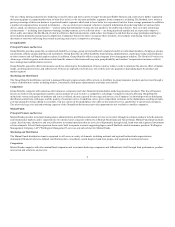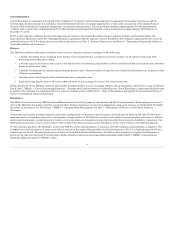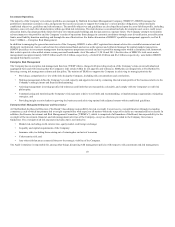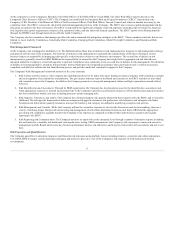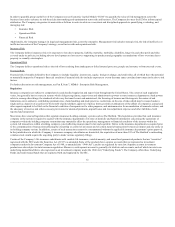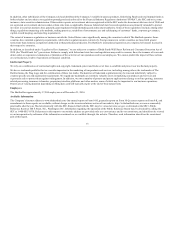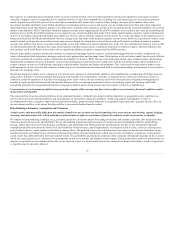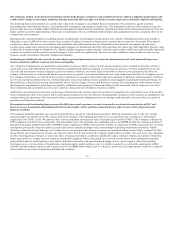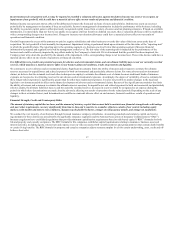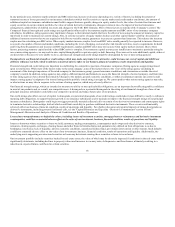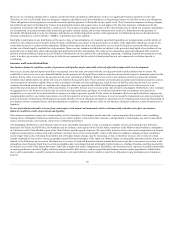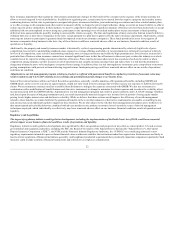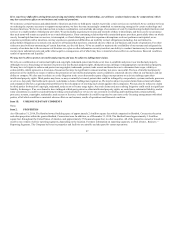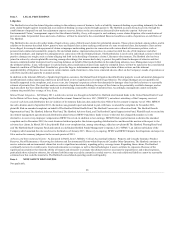The Hartford 2014 Annual Report Download - page 18
Download and view the complete annual report
Please find page 18 of the 2014 The Hartford annual report below. You can navigate through the pages in the report by either clicking on the pages listed below, or by using the keyword search tool below to find specific information within the annual report.
In any particular year, statutory surplus amounts and RBC ratios may increase or decrease depending on a variety of factors, including the amount of
statutory income or losses generated by our insurance subsidiaries (which itself is sensitive to equity market and credit market conditions), the amount of
additional capital our insurance subsidiaries must hold to support business growth, changes in equity market levels, the value of certain fixed-income and
equity securities in our investment portfolio, the value of certain derivative instruments, changes in interest rates, the impact of internal reinsurance
arrangements, admissibility of deferred tax assets and changes to the NAIC RBC formulas. Most of these factors are outside of the Company's control. The
Company's financial strength and credit ratings are significantly influenced by the statutory surplus amounts and RBC ratios of our insurance company
subsidiaries. In addition, rating agencies may implement changes to their internal models that have the effect of increasing the amount of statutory capital we
must hold in order to maintain our current ratings. Also, in extreme scenarios of equity market declines and other capital market volatility, the amount of
additional statutory reserves that we are required to hold for our variable annuity guarantees increases at a greater than linear rate. This reduces the statutory
surplus used in calculating our RBC ratios. When equity markets increase, surplus levels and RBC ratios would generally be expected to increase. However,
as a result of a number of factors and market conditions, including the level of hedging costs and other risk transfer activities, reserve requirements for death
and living benefit guarantees and increases in RBC requirements, surplus and RBC ratios may not increase when equity markets increase. Due to these
factors, projecting statutory capital and the related RBC ratios is complex. If our statutory capital resources are insufficient to maintain a particular rating by
one or more rating agencies, we may seek to raise capital through public or private equity or debt financing. If we were not to raise additional capital, either at
our discretion or because we were unable to do so, our financial strength and credit ratings might be downgraded by one or more rating agencies.
Downgrades in our financial strength or credit ratings, which may make our products less attractive, could increase our cost of capital and inhibit our
ability to refinance our debt, which would have a material adverse effect on our business, financial condition, results of operations and liquidity.
Financial strength and credit ratings are important in establishing the competitive position of insurance companies. Rating agencies assign ratings based
upon several factors. While most of the factors relate to the rated company, some of the factors relate to the views of the rating agency (including its
assessment of the strategic importance of the rated company to the insurance group), general economic conditions, and circumstances outside the rated
company's control. In addition, rating agencies may employ different models and formulas to assess the financial strength of a rated company, and from time
to time rating agencies have altered these models. Changes to the models, general economic conditions, or other circumstances outside our control could
impact a rating agency's judgment of its internal rating and the publicly issued rating it assigns us We cannot predict what actions rating agencies may take,
or what actions we may take in response to the actions of rating agencies, which may adversely affect us.
Our financial strength ratings, which are intended to measure our ability to meet policyholder obligations, are an important factor affecting public confidence
in most of our products and, as a result, our competitiveness. A downgrade or a potential downgrade in the rating of our financial strength or of one of our
principal insurance subsidiaries could affect our competitive position and reduce future sales of our products.
Our credit ratings also affect our cost of capital. A downgrade or a potential downgrade of our credit ratings could make it more difficult or costly to refinance
maturing debt obligations, to support business growth at our insurance subsidiaries and to maintain or improve the financial strength ratings of our principal
insurance subsidiaries. Downgrades could begin to trigger potentially material collateral calls on certain of our derivative instruments and counterparty rights
to terminate derivative relationships, both of which could limit our ability to purchase additional derivative instruments. These events could materially
adversely affect our business, financial condition, results of operations and liquidity. For a further discussion of potential impacts of ratings downgrades on
derivative instruments, including potential collateral calls, see the "Capital Resources and Liquidity - Derivative Commitments" section of Item 7.
Management's Discussion and Analysis of Financial Condition and Results of Operations.
Losses due to nonperformance or defaults by others, including issuers of investment securities, mortgage loans or reinsurance and derivative instrument
counterparties, could have a material adverse effect on the value of our investments, business, financial condition, results of operations and liquidity.
Issuers or borrowers whose securities or loans we hold, customers, trading counterparties, counterparties under swaps and other derivative contracts,
reinsurers, clearing agents, exchanges, clearing houses and other financial intermediaries and guarantors may default on their obligations to us due to
bankruptcy, insolvency, lack of liquidity, adverse economic conditions, operational failure, fraud, government intervention or other reasons. Such defaults
could have a material adverse effect on the value of our investments, business, financial condition, results of operations and liquidity. Additionally, the
underlying assets supporting our structured securities or loans may deteriorate causing these securities or loans to incur losses.
Our investment portfolio includes securities backed by real estate assets, the value of which may be adversely impacted if conditions in the real estate market
significantly deteriorate, including declines in property values and increases in vacancy rates, delinquencies and foreclosures, ultimately resulting in a
reduction in expected future cash flows for certain securities.
18


